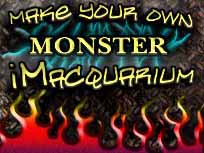The iMacquarium is composed of the plastic shell of a CRT iMac, a support structure inside of the shell and a small aquarium tank that sits inside of the case to resemble the iMac's monitor.
(1) An iMac:
Please don't trash a good Mac. Any CRT iMac can be a friendly home to fish, but if you have a working iMacDV (or later) that has FireWire, it's not obsolete. It can even run OS X 10.3 at a respectable clip. My cutting guide isn't sized for anything more recent than the early tray-loading iMacs. [TIP-02]
(2) Sheet(s) of plastic:
Use 1/4-inch acrylic for this project. [TIP-03] Lexan plastic is expensive, isn't as clear as acrylic and isn't easy to cut (some window stores will cut it for you). [TIP-04] Some 1/8-inch acrylic is useful -- not necessary -- for supplementing the basic iMacquarium. 1/8-inch acrylic isn't a good material for the tank because it flexes easily so it's harder to work with when the tank is filled. Glass may be used, but it's fragile, can be deadly sharp and the advice on this site is geared towards using plastic. [TIP-05]
(3) Cutting tools, straight-edge:
You need to score or cut the plastic from sheets. You could use power tools. A circular saw mounted on a big bench is the ideal cutter. A reciprocating saw would work, but it's hard to get a straight line with one. I live in a tiny apartment and did most of this project on the floor or on my dinner table [TIP-06], so I relied on less sophisticated instruments. A "professional" scoring tool from Home Depot was useless, but the back-edge of a #24 X-ACTO knife scores very well along a straight-edge or ruler and a Dremel rotary tool with a 1/8-inch tile-cutting tip [TIP-07] will cut holes, enlarge holes, trim edges and smooth surfaces for tight seams. This job would be a royal PITA without a Dremel or similar rotary tool.
(4) Adhesives, cement, solvent:
There's better stuff than silicone aquarium adhesive. The silicone stuff is messy, takes a long time to dry and doesn't bond well to plastic. Use plastic solvent/cement, which sets in a matter of seconds or minutes. It's typically only available from specialty stores. The solvent binds to the plastic like a weld to make a very strong joint. There are two kinds of cement for this job: one for making the initial joint and a thicker one for filling gaps and adding support. [TIP-08] I also used aquarium adhesive on my tank because my "Monster" revisions made me paranoid about leaks, but it wasn't necessary.
(1) Clamps:
Corner-clamps are helpful for the 90-degree join at the back. If you decide to bend the main structure [TIP-09], you'll need table-clamps with substantial (8-inch or more) depth to get the best leverage.
(2) Craftboard and white craft glue:
I made a craftboard model before assembling my tank from plastic. You should make one, too. My design has close tolerances and if your iMac has the slightest deviation from mine, you'll have to modify the plans. Building the model allowed me to figure out how I wanted to make a support structure and it gave me the opportunity to try a few ideas that didn't pan out. [TIP-10]
(3) Heat-gun:
Because of the odd shape of the tank with its sloping sides, one or both of the sides probably won't join to the tank without some bending or filling. It's possible to fill in gaps using plastic cement and/or silicone aquarium adhesive, but I wouldn't trust a filled gap of more than 1/8-inch. Plus, the heat gun came in handy for my "Monster" modifications. [TIP-11]
(4) Epoxy, glue gun, model cement:
Some elements need to be glued down. 'Nuf said?
(5) Level, eye-protection, rubber feet, shielding, screws, plastic rods and cubes:
Use a level. It looks odd if the water-line isn't parallel to the frame. Wear safety glasses whenever you use power tools or snap plastic. I used clear rubber "feet" to mark the places where the tank should rest in the case and to dampen vibration from the airpump. The 1/8-inch plastic makes a good splash-shield and airpump-holder inside the tank. Leftover screws from the iMac can be used to secure the lower part of the case and more. I used little plastic rods and cubes to elevate some of the "Monster" components. [TIP-12]


